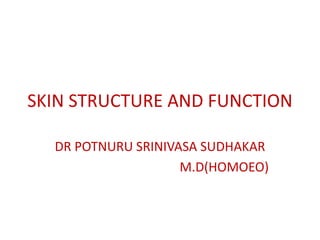This document summarizes the structure and function of human skin. It describes the two main layers of skin - the epidermis and dermis. The epidermis contains 5 layers including the stratum corneum, stratum granulosum, and stratum basale. The dermis lies below the epidermis and contains collagen, blood vessels, nerves, hair follicles, and glands. The skin acts as a protective barrier, regulates temperature and moisture, senses touch and pain, and plays a role in vitamin D production, acid-base balance, and waste excretion. The document also describes sweat glands and their role in thermoregulation.























































